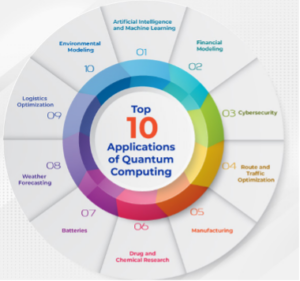
By Vipin Jain
(What follows is Part 2 of Quantum Computing Demystified. Part 1 appeared yesterday.)
Transformative Applications Across Industries
Quantum computing is set to revolutionize a wide array of industries by offering solutions to some of the most complex challenges faced today. Its transformative applications across sectors underscore the vast potential of this emerging technology to not only enhance operational efficiencies but also to pioneer new paradigms in product and service offerings. Here, we explore the profound impact quantum computing is poised to have across key industries:
key industries:
Finance
Quantum computing promises to redefine finance through advanced algorithms capable of revolutionizing portfolio management, risk assessment, and fraud detection. Its ability to process complex financial data in real-time may lead to more resilient and efficient markets. Portfolio optimization, risk analysis, and fraud detection stand to benefit significantly from quantum computing’s parallel processing capabilities, enabling a more comprehensive analysis of assets, market conditions, and transaction data.
Pharmaceuticals
In pharmaceuticals, quantum computing’s potential to simulate molecular interactions at the quantum level could dramatically expedite drug discovery, making the development of new treatments faster and more cost-effective. By providing detailed insights into drug efficacy and side effects at an early stage, quantum computing could drastically shorten the time to market for new medications, addressing diseases that are currently difficult to manage.
Logistics and Manufacturing
Quantum computing has the power to transform logistics and manufacturing by optimizing supply chains and production processes. It can solve NP-hard problems like the traveling salesman and knapsack problems more efficiently than classical computers, leading to significant improvements in operational efficiency, waste reduction, and cost savings. Supply chain optimization, in particular, could achieve unprecedented levels of efficiency, benefiting from quantum computing’s ability to analyze and optimize vast networks of variables in parallel.
Energy
In the energy sector, quantum computing can enhance grid distribution and facilitate the development of materials for more efficient energy storage, supporting the transition towards renewable energy sources. By modeling complex energy systems, quantum computing can optimize energy distribution, minimize losses, and improve the integration of renewable energy into the grid, making power systems more reliable and sustainable.
Quantum computing’s entry into these sectors signifies a shift towards more advanced, efficient, and sustainable industry practices. Early adopters of quantum technology may secure a significant competitive advantage, leveraging quantum computing’s unparalleled computational power to address intricate challenges, enhance decision-making, and drive innovation. As industries navigate the complexities of integrating quantum computing into their operations, the focus will be on developing the skills, strategies, and infrastructures necessary to harness this transformative technology effectively.
Quantum Future: Strategic Challenges and Implications
The emergence of quantum computing brings forth a spectrum of challenges and strategic implications for cybersecurity, business leadership, and policy formulation. Quantum computing’s potential to invalidate current cryptographic standards necessitates a paradigm shift towards the development of quantum-resistant encryption methods, safeguarding digital infrastructures against future quantum threats. This scenario underscores the urgency in fortifying cybersecurity frameworks to withstand the capabilities of quantum algorithms.
For decision-makers and policymakers, the quantum computing era presents a dual-edged sword of strategic opportunities and challenges. The imperative to embrace this nascent technology is twofold, requiring substantial investment in research, development, and education to cultivate a quantum-literate workforce. Early adoption and experimentation with quantum technologies can furnish organizations with a competitive advantage, enabling them to unearth valuable applications and seamlessly integrate quantum solutions into their operational frameworks.
Addressing the multifaceted challenges posed by quantum computing necessitates a holistic approach, encompassing technical hurdles, algorithmic innovation, practical implementation strategies, cybersecurity vigilance, workforce development, and ethical governance:
Technical and Algorithmic Advancements: Overcoming the technical obstacles of qubit coherence, scalability, and error correction is paramount. Concurrently, the quest for groundbreaking quantum algorithms and the development of quantum-friendly software and programming models remains central to harnessing quantum computing’s full potential.
Practical Integration and Cybersecurity: The integration of quantum systems with existing classical infrastructures, coupled with the transition to quantum-resistant cryptographic practices, constitutes a critical strategic focus. These measures are essential to ensure the seamless deployment and security of quantum technologies.
Workforce Development and Ethical Considerations: Bridging the quantum expertise gap through education and training is vital for fostering a skilled workforce capable of driving quantum innovation forward. Moreover, ethical and regulatory frameworks must evolve in tandem with quantum advancements to ensure equitable access and prevent misuse, thereby safeguarding societal and economic interests.
Navigating the quantum future demands a concerted effort across technical, strategic, and ethical dimensions. Organizations and governments must proactively address these challenges, laying a solid foundation for a quantum-resilient society and capitalizing on the transformative potential of quantum computing across various sectors.
Key Implications of Quantum Computing Adoption
Quantum computing’s advancement necessitates strategic foresight and adaptability from leaders across sectors. Here’s a distilled overview of critical strategic considerations:
R&D Investment: Prioritize investments in quantum R&D or partnerships to secure a competitive edge in sectors like pharmaceuticals, cryptography, and materials science.
Strategic Planning: Integrate quantum computing into strategic planning to harness its potential for innovation and competitive advantage.
Talent Development: Address the quantum skill gap through workforce training and recruitment of specialists in quantum physics and related fields.
Cybersecurity Reinforcement: Prepare for quantum’s impact on encryption by advancing cybersecurity strategies with quantum-resistant technologies.
Regulatory Engagement: Participate in shaping ethical guidelines and standards for quantum computing, focusing on privacy and security.
Innovation Culture: Maintain agility by fostering innovation and preparedness for quantum-driven disruptions.
Operational Optimization: Explore quantum algorithms for enhancing efficiency in logistics, supply chains, and manufacturing.
Strategic Partnerships: Forge collaborations with quantum firms and research bodies for access to resources and shared innovation.
Flexible Long-term Vision: Adopt a visionary yet adaptable approach to quantum computing strategies, ready to pivot as the technology evolves.
Ethical AI Considerations: Ensure AI advancements driven by quantum computing adhere to ethical, transparent, and accountable practices.
Leaders must balance the transformative promise of quantum computing against its challenges, adopting early engagement and informed strategies to harness this technology for future success effectively.
Concise Roadmap for Quantum Computing Adoption
Adopting quantum computing within an organization necessitates a strategic, phased approach that ensures a smooth transition from traditional computing paradigms to the quantum era. This roadmap is designed to facilitate organizations in building foundational knowledge, assessing strategic implications, developing talent, conducting targeted experimentation, and ultimately integrating quantum computing solutions into their  operations. Here’s a streamlined guide to navigating this journey:
operations. Here’s a streamlined guide to navigating this journey:
Awareness and Education: Establish a broad understanding of quantum computing’s potential and challenges. Host educational workshops for key stakeholders, identify internal quantum advocates, and stay abreast of industry developments.
Strategic Assessment: Gauge the impact of quantum computing on your business. Conduct a SWOT analysis to uncover potential quantum computing applications, evaluate the competitive landscape, and pinpoint opportunities for innovation.
Talent Acquisition and Development: Cultivate or acquire the necessary quantum computing expertise. Collaborate with academic bodies for training, hire quantum specialists, and promote a culture of learning and innovation.
Experimentation and Pilot Projects: Validate the practical utility of quantum computing through pilot initiatives. Identify and implement pilot projects, partner with quantum technology providers for resources and support, and assess project outcomes for insights and improvements.
Infrastructure and Ecosystem Integration: Ready the organization for quantum integration. Upgrade IT infrastructure as needed, engage with the quantum ecosystem for partnerships, and map out the integration of quantum computing into business processes.
Implementation and Scaling: Broaden the application of successful quantum initiatives. Develop comprehensive plans for scaling quantum applications, continually monitor the quantum landscape for strategic adjustments, and ensure robust cybersecurity for quantum-enhanced operations.
Evolution and Continuous Innovation: Incorporate quantum computing into ongoing innovation efforts. Implement a feedback loop for quantum initiatives, foster interdisciplinary collaboration for new quantum applications, and maintain active engagement with the quantum community.
This roadmap is dynamic, recognizing the fast-paced evolution of quantum computing. Organizations are encouraged to periodically reassess and refine their quantum strategies, ensuring they remain aligned with technological advancements and organizational learning. Adopting quantum computing is an iterative, ongoing process of exploration, adaptation, and innovation, positioning organizations at the forefront of the quantum revolution.
Conclusion
Quantum computing represents a seismic shift in computational capabilities, offering unparalleled power to address complex challenges across various sectors. This transformative technology, as highlighted throughout our discussion, extends far beyond the realms of classical computing, propelling us into a new era of problem-solving and innovation.
The exploration of quantum computing’s core principles and its stark contrast with classical paradigms sheds light on its potential to revolutionize industries such as finance, pharmaceuticals, and energy. Its capabilities to enhance efficiency, accelerate research, and foster advancements in material science and cybersecurity underscore the breadth of its impact.
However, realizing the full promise of quantum computing is contingent upon overcoming substantial hurdles, including enhancing qubit coherence, refining error correction techniques, and developing sophisticated algorithms. The technology’s progression also mandates a strategic reevaluation of cybersecurity frameworks, as traditional encryption methods may no longer suffice in a quantum-dominated landscape.
For leaders and decision-makers, quantum computing necessitates a forward-looking, proactive stance. Organizations must cultivate quantum literacy, invest in talent development, and explore quantum’s practical applications today to secure a competitive advantage tomorrow. The journey towards quantum integration involves a structured roadmap, guiding businesses through stages of awareness, assessment, and experimentation, leading to full-scale adoption.
In conclusion, as we approach the dawn of a new computational epoch, the responsibility and opportunity lie with current leaders to navigate this quantum frontier. By championing innovation, fostering partnerships, and prioritizing continuous learning, organizations can unlock the extraordinary potential of quantum computing. Together, we can redefine the limits of computation, steering towards a future where quantum technology plays a central role in solving the world’s most intractable problems.
Author
Vipin Jain is the founder and Chief Architect at Transformation Enablers Inc. (TXE.AI) in Chantilly, Virginia, USA. With over three decades of technology management and solution delivery experience, Jain specializes in developing and implementing IT strategies and plans aligned with business goals, solution architecture, digital transformation roadmaps, portfolio optimization, and the deployment of global business solutions.
Before founding TXE, Jain held various executive roles at Microsoft, Accenture, HPES, and TEKsystems, advising Fortune 500 companies and US federal agencies on innovative solutions. His career also includes executive positions at AIG, Merrill Lynch, Citibank, First Chicago, and Empire Blue Cross Blue Shield, where he managed technology for enterprise-wide initiatives and conducted due diligence for potential acquisitions.
Jain’s experience spans large and small commercial firms, US federal and state government agencies, and management consulting, covering multiple business sectors like banking, brokerage, insurance, healthcare, pharmaceuticals, energy, and government. He is actively involved in industry groups such as ACT-IAC and SIMCAC, focusing on public sector digital and IT transformation, big data, and cloud technologies, in addition to being a member of IASA Global and the Chief Architect Forum.
Vipin can be reached at Vipin@txe.ai.
